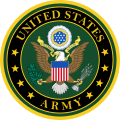80th Regiment "Nunc Ut Olim" (Now As Before)
86th Infantry "Courage and Dependability"
100th Regiment
(formerly 375th Field Artillery Regiment)
"Sic Jurat Transcendere Montes" (Thus He Swears To Cross The Mountains)
111th Medical Battalion "Dedicated And Diligent"
154th Regiment
(formerly 154th Infantry Regiment)
"Firm To My Trust"
175th Regiment (formerly 175th Field Artillery Regiment)
"Animus Valet" (Courage Prevails)
200th Regiment
(formerly 200th Infantry Regiment)
"Crede et vince" (Believe And Conquer)
205th Regiment (formerly 205th Air Defense Regiment)
"Res Verae" (Data Correct)
243rd Regiment (formerly 243rd Coast Artillery Regiment)
260th Regiment (formerly 260th Coast Artillery Regiment)
"Ferio, tego" (I Strike, I Defend)
307th Regiment
(formerly 307th Infantry Regiment)
"Clear the Way"
311th Regiment
(formerly 311th Infantry Regiment)
"Jamais Trop Tard" (Never Too Late)
312th Regiment
(formerly 312th Infantry Regiment)
"Au Feu Toujours" (Always at the Fire)
315th Regiment
(formerly 315th Infantry Regiment)
"Qui Me Tangit Paenitebit" (He who touches me will repent)
337th Regiment
"Vis et Virtus" (Strength and Courage)
338th Regiment
"Marchons" (March On)
339th Regiment
(formerly 339th Infantry Regiment)
340th Regiment
"Forward"
345th Regiment
"Invictus" (Unconquerable)
346th Regiment
"Semper Et Ubique Fidelis" (Always and Everywhere Faithful)
347th Regiment
"Dare Your Best"
348th Regiment
(formerly 348th Infantry Regiment)
"AnLI yamojmikma KAMASSA" (Sincerity and Strength)
349th Regiment
"Liberty and Rights"
350th Regiment
"Fidelity and Service"
351st Regiment
(formerly 351st Infantry Regiment)
"Toujours Prêt" (Always Ready)
353rd Regiment
(formerly 353rd Infantry Regiment)
"To the Stars Through Difficulties"
354th Regiment
(formerly 354th Infantry Regiment)
"Wright, Wood, Winn"
355th Regiment "Fidem Praestabimus" (We Will Keep the Faith)
356th Regiment
"Boutze en Avant" (Push Forward)
357th Regiment
"Siempre Alerta" (Always on Alert)
358th Regiment "Peragimus" (We Accomplish)
359th Regiment
"Carry On"
360th Infantry
"Toujours Fidèle" (Always Faithful)
361st Regiment
"Ducit amor patriae" (Led by Love of Country)
362nd Regiment
"Arma Tuentur Pacem" (Arms Are the Guardian of Peace)
363rd Regiment
(formerly 363rd Infantry Regiment)
"We Do"
364th Regiment
(formerly 364th Coast Artillery Regiment)
"Semper Paratus" (Always Ready)
377th Regiment (formerly 377th Infantry Regiment)
"NI GA DA E SA SDI" (Onward)
378th Regiment
(formerly
378th Infantry Regiment)
"Hikia Kallo" (Stand Firm)
379th Regiment
(formerly 379th Infantry Regiment)
"Ad finem" (To The End)
381st Regiment
(formerly 381st Infantry Regiment)
"Paratus et Vigilans" (Ready and Alert)
382nd Regiment (formerly 382nd Infantry Regiment)
"We lead"
383rd Regiment
(formerly 383rd Infantry Regiment)
"Dependable"
385th Regiment
(formerly 385th Infantry Regiment)
"Follow Me"
389th Regiment
(formerly 389th Infantry Regiment)
"We Will Try"
390th Regiment
(formerly 390th Infantry Regiment)
"KA-YEN-SA-HAH" (Keep The Flag Flying)
391st Regiment
(formerly 391st Infantry Regiment)
"We Will Always Win"
392nd Regiment
(formerly 392nd Infantry Regiment)
"Pace et bello paratus" (Prepared for Peace and War)
393rd Regiment
(formerly 393rd Infantry Regiment)
"Patriotic Service"
394th Regiment
(formerly 394th Infantry Regiment)
"Audax Et Cautus" (Bold and Wary)
395th Regiment (formerly 395th Infantry Regiment)
"Vigilans Et Celer" (Vigilant and Swift)
397th Regiment
(formerly 397th Infantry Regiment)
"Death before dishonor"
398th Regiment
(formerly 398th Infantry Regiment)
"On the alert"
399th Regiment
(formerly 399th Infantry Regiment)
"I AM Ready"
400th Regiment
(formerly 400th Infantry Regiment)
"United we stand"
409th Regiment (formerly 409th Infantry Regiment)
"Steadfast"
410th Regiment
(formerly 410th Infantry Regiment)
"Super Ardua Surgo" (I Rise Above Difficulties)
411th Regiment
(formerly 411th Infantry Regiment)
"Paratus ferier" (Ready to Strike)
413th Regiment
(formerly 413th Infantry Regiment)
"Foritior Ex Asperis" (Stronger After Difficulties)
414th Regiment "Si Vis Pacem Para Bellum" (If You Wish Peace, Prepare For War)
415th Regiment (formerly 415th Infantry Regiment)
"Old faithful"
416th Regiment
(formerly 416th Infantry Regiment)
"Ne plus ultra" (Nothing Beyond or Better)
417th Regiment
(formerly 417th Infantry Regiment)
"Spirit of '76"
418th Regiment
(formerly 418th Infantry Regiment)
"Semper Pugnare Paratus" (Always Ready To Fight)
421st Regiment
(formerly 221st Field Artillery Regiment)
"Sobre Todo" (Above The Rest)
426th Regiment
(formerly 426th Infantry Regiment)
"Aeternusa Vigilantis" (Eternal Vigilance)
485th Regiment
(formerly 424th Infantry Regiment)
"Perrumpo" (I Break Through)
501st Infantry Regiment
"
GERONIMO"
518th Regiment
(formerly 518th Infantry Regiment)
"Virtus, Fides, Honor"
640th Regiment
(formerly 140th Field Artillery Regiment)
"Igne Et Ferris Vicimus" (We Conquered By Fire And Swords)






















































































































